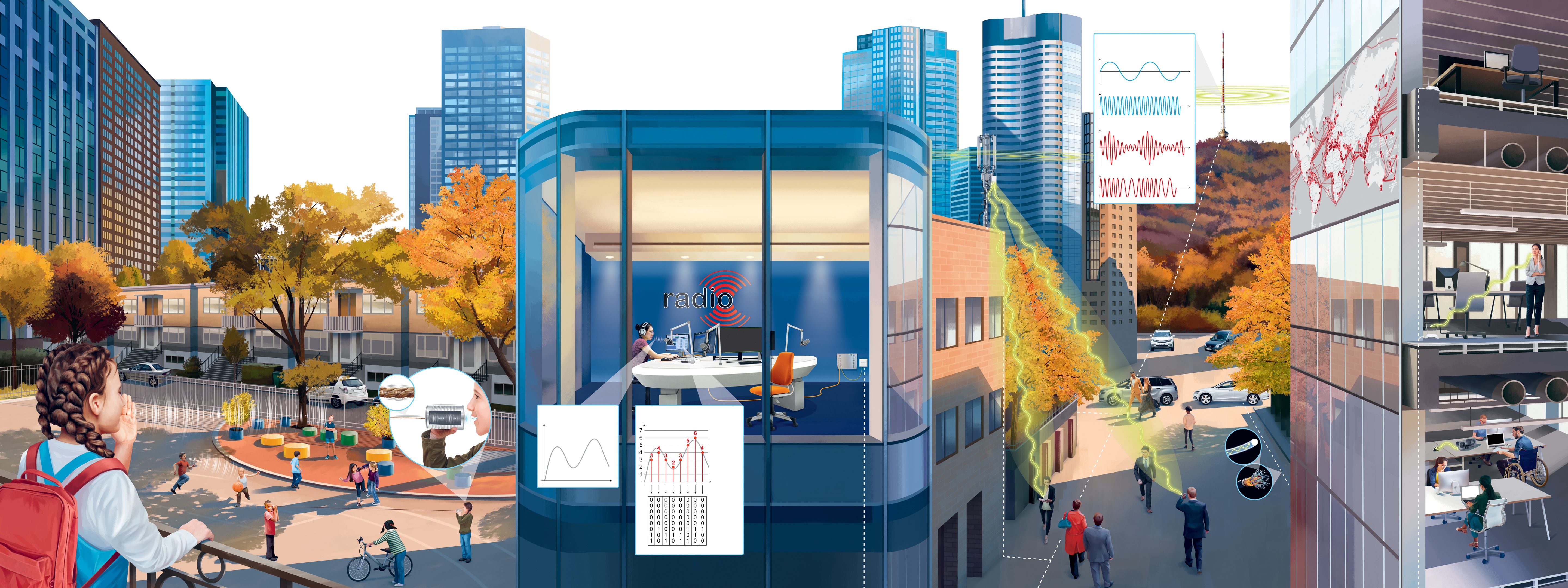Data Travels Around the World
Using waves for communication thanks to their information content
Waves carry information. As waves propa-gate, the information reaches other places where it can be received and
retrieved. This is how we communicate with each other and connect globally.

Connected Globally
Ever more data is to be transmitted faster, farther and in ever better quality. This requires a well-developed network of connections – similar to a well-developed road network.
Copper cables are increasingly being replaced by fibre optic cables, through which data can be transported much faster. In addition, there is hardly any loss of quality – even over long distances. In order to connect the whole world at high speed, the submarine fibre optic networks are being further expanded. Our mobile phone network is also connected to the fibre optic network – with the connection between mobile phone and antenna itself being wireless.
Be it radio, mobile communications or the military, all fields have their own frequency ranges so as not to interfere with each other’s data transmission. Data volumes have become so large and users so numerous that the available frequencies are increasingly being used to capacity and several mobile phone users have to share the same frequency. As a result, phone calls are divided into data packets so that they can be transmitted in smaller chunks and thus almost simultaneously.
With 5G, additional higher frequencies become available for mobile communications – like new lanes on a motorway. With these additional ‘lanes’, more data can be transmitted at the same time, so that the transmission of a certain amount of data is faster. Since the range of the higher frequencies is smaller, more antennas are needed for good network coverage. However, data is only transmitted to the users in ‘beams’ with exactly the required signal strength instead of being sent nonstop in all directions.
Packaged Electronically
Speech and music transmitted as sound waves have a rather short range. If we want to bridge greater distances, we have to convert the air oscillations of the sound waves into an electric signal. The voice of a radio presenter thus becomes a sound curve. This curve is continuous or analogue, i.e. it has no interruptions or steps. In this form, the spoken word can be transmitted via copper cables.
Nowadays, however, signals are usually transmitted in digital form. To do so, the sound curve is digitised, i.e. its waveform is sampled at regular intervals and thus re-recorded. The resulting signal consists of individual values, reducing the amount of data. The values are translated into sequences of 0 and 1 – similar to Morse codes, where a sequence of short and long marks is assigned to each letter of the alphabet.
Both analogue and digital signals can be ‘packaged’ into electromagnetic waves in order to transmit them wirelessly or with light through fibre optic cables. The electromagnetic waves serve as carrier waves and reproduce the shape of the signal. In amplitude modulation (AM), the signal is reproduced by the amplitudes of the carrier wave, whereas in frequency modulation (FM), the signal is reproduced by the frequencies.
Spoken Locally
When we speak, we produce sound waves. They are formed because our vocal chords cause the air to vibrate. With our mouths, we can shape the waves into recognisable sounds. When we put them together into words and sentences, we can communicate with others.
When we talk with people near us, our conversation is transmitted through the air. But we can also communicate through a medium other than air. This is demonstrated in a playful way by a tin can telephone, which carries the sound waves through a tautly stretched string: the sound of the speech emitted by one person hits the bottom of the can, which begins to vibrate and transmits the vibrations to the string. At the other end, the vibrations are transferred from the string back to the bottom of the other can and from there back into the air. The sound waves can now be heard as speech by the second person.